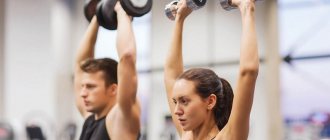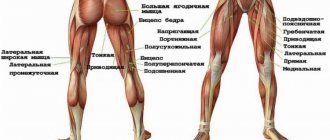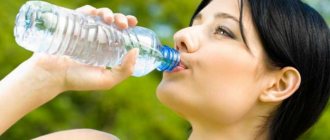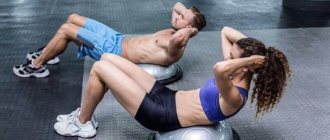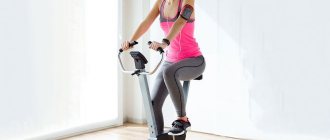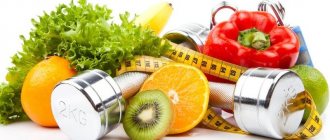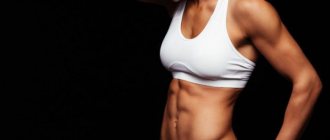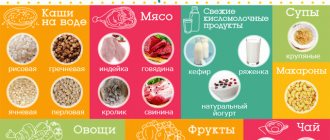Hormones are a secret secreted by the endocrine glands of the human body. Almost all of his physiology is under their constant control: energy exchange, reproductive functions, tissue growth, the level of water-alkaline metabolism, synthesis and inhibition of muscle protein, neurological and mental reactions. The vigorous activity of these substances cannot but affect human life, including physical activity. About what hormone is produced when playing sports, after removing the load on the body, how the excess and deficiency of certain substances affects the condition of a person who regularly or periodically carries loads of varying intensity.
Interesting! Well-known endorphins give moments of happiness, but not everyone knows that in addition to chocolate and hugs, this substance is also released by sports. Moreover, whenever possible, preference should be given to group classes - it is game sports and collective training that can provide maximum pleasure.
Types and features
Substances produced by the endocrine glands are unique chemical compounds that determine the type of interaction with various receptors in the body. They are classified in three categories:
- steroids;
- peptides;
- amines.
Steroids interact with molecules of the cell nucleus, peptides are based on amino acids and contact the cell membrane, nitrogen-based amines work with the nervous system. In addition, catabolic and anabolic secretions are secreted. If a catabolic hormone is produced during sports, muscle tissue is destroyed. Anabolic steroids, on the contrary, stimulate cell reproduction, which leads to an increase in muscle mass. It is the balance of these components in the body that determines the success of training for both fitness enthusiasts and half-hearted exercises, as well as professional athletes.
Carefully! Endocrine glands are very delicate mechanisms. It is important to take care of the balance and make adjustments only if there is an urgent need. And this must be done exclusively under the supervision of specialists, because the harm caused may be more significant than the expected benefit.
Considering hormones and sports in tandem, it should be mentioned that unskilled intervention in the balance of substances produced naturally is fraught with many troubles. Thus, abuse of male secretions in women causes infertility, and in men, anabolic steroids provoke testicular dysfunction, decreased libido and other abnormalities.
How does exercise affect the endocrine system?
There is the concept of “hormonal response”, which refers to the reaction of catabolic and anabolic hormones to training. Catabolic hormones regulate the breakdown and oxidation of substances in the body. For example, these include the “stress hormones” adrenaline and cortisol. Anabolic hormones are building hormones. They are responsible for the restoration and renewal of cells and tissues. In particular, the anabolic hormones somatotropin (growth hormone) and testosterone respond to physical activity.
From the first minutes of physical activity, the cardiovascular, respiratory, nervous and endocrine systems are involved. The “stress hormones” adrenaline and cortisol are released. It is a mistake to believe that “stress hormones” are harmful to the body. They are useful when they are released in a short period of time and work correctly. Cortisol mobilizes, reduces inflammation and raises blood sugar levels to give the body energy. It’s harmful when stress affects us constantly, cortisol is constantly produced, sugar is constantly elevated - then the system simply wears out.
The goal of health training is to stimulate hormones.
The training must be stopped when the body still has the resources to recover; in this case, anabolic hormones come into play. They are responsible for burning fat, building muscles and strengthening bone tissue. When their level is normal, tissues are renewed, built and prepared for new challenges. If a person receives the necessary load during training and fully recovers after it, he will become healthier, stronger, more resilient, and cope better with stress.
What types of secretions are actively produced during sports activities?
When playing sports, several organs produce hormones at once. The pancreas, adrenal glands, gonads, and pituitary gland are involved in this process. They are actively involved in the processes of thermoregulation of the body, increasing endurance and building muscle mass, improving reaction, launching metabolic resources, etc. That is, almost all the parameters that ensure the effectiveness of physical activity are a consequence of the work of unique chemical compounds produced by our body. So, what hormones are released during sports and how do they affect the training and competitive process?
- Insulin. Produced by the pancreas. Responsible for the body's metabolic processes in terms of carbohydrates and fats. Promotes the storage and absorption of glycogen and glucose into the blood, helps reduce sugar levels by stimulating its absorption from the blood into muscles and adipose tissue. In some cases, fat cells take priority, and muscles are left without proper energy supply. During physical activity, insulin generation is suppressed, so athletes refuse sweets in any form. Eating sugar increases the amount of a substance that carefully stores glycogen in the body, instead of stimulating physical activity. And one more recommendation - it’s better to start using sports drinks or energy gels after sweating begins.
- Growth factor IGF (insulin-like). A peptide type generated in the liver, its molecular structure is similar to regular insulin. Restores protein destroyed during exercise and stimulates muscle growth.
- HGH is a growth hormone, in sports it is responsible for cell growth, like other anabolic secretions. Produced by the pituitary gland during periods of sleep. Stimulates the building of muscle mass, mineralization of bone tissue, supports the immune system, and ensures lipolysis or metabolism of fat cells. Necessary for intense training that causes blood lactate (production of lactic acid).
- An important hormone during exercise is glucagon, which is released by the pancreas when sugar levels are low. Stimulates the production of fatty acids from tissue fat reserves, increasing blood glucose levels, ensuring a high level of athlete activity. Glycogen consumed during exercise is released from the liver.
- Cortisol is also a hormone released during exercise that regulates blood sugar levels. This steroidal catabolic secretion is produced by the adrenal glands as a response to stress caused by exercise. Facilitates the breakdown of protein and triglycerides, creating energy-rich glucose molecules.
- Adrenaline and norepinephrine produce the energy needed for successful workouts. Secretions of the amine group are secreted by the adrenal glands.
- Another answer to the question of what hormone is released during sports training is testosterone. A steroid secretion produced by the testes and ovaries of men and women, respectively. It is also secreted in small quantities by the adrenal glands. Its task is to restore muscle protein destroyed during training. Working with specific receptor signals, this substance becomes a response to damage to muscle tissue.
The effect of hormones during exercise on muscle hypertrophy
And muscle adaptation to stress in the form of hypertrophy is regulated to a greater extent by intracellular changes than by external stimuli coming from anabolic hormones. True, this is only true for those cases where the concentration of anabolic hormones is within normal human physiology. Artificially increased hormonal levels many times over already have a much stronger effect on the hypertrophy of muscle cells.
Natural, physiological concentrations are practically not responsible for muscle growth in response to strength training. Research convincingly demonstrates that both temporary acute changes in hormone levels in response to stress and long-term chronic changes, both up and down, do not significantly affect adaptive hypertrophy. Physical activity initiates the activation of signaling pathways in muscle cells that control enzymes responsible for protein synthesis. In addition, hormone-like substances are formed right inside the cell in response to stress - mechanical growth factor, insulin-like growth factor.
Their effect on muscle cells in relation to protein metabolism is similar to that of somatropin and insulin combined. Reduced breakdown and increased synthesis. Interestingly, such local changes in response to stress persist in the muscles until old age. Therefore, in case of sarcopenia - age-related loss of muscle mass and strength, despite the natural decrease in the level of anabolic hormones (testosterone, growth hormone) in old age, resistance training is recommended. They successfully resist it. Both strength and muscle mass increase. Just like physical activity is recommended for people with diabetes. Inadequate insulin functioning or its deficiency is compensated by physical activity, which, as mentioned above, can duplicate hormonal effects and, in addition, increase sensitivity to hormonal signals.
How to use a useful “tool”
Knowledge of what hormone is produced during training in sports helps to correctly select the level of stress, intensity and duration of training, and the athlete’s diet. Specialized nutrition, all kinds of protein shakes, energy drinks are very important, for example, in bodybuilding, when building muscles or for quickly getting in shape after a break in training.
Important! Do not forget that some drugs are prohibited for use by athletes. These are anabolic steroids - derivatives of testosterone, a peptide group that includes insulin, growth hormone, erythropoietin. Elevated levels of these substances may result in temporary or lifelong disqualification.
It is very important to ensure that after sports, hormones, the levels of which are changed by exercise, return to normal levels in normal conditions, ensuring a healthy balance in the body.
Estrogen
Female sex hormones, in particular, their most active representative 17-beta-estradiol, help to use fat reserves as a source of fuel, elevate mood and improve emotional background, increase the intensity of basal metabolism and increase sexual desire (in women). You also probably know that in the female body the concentration of estrogen varies depending on the state of the reproductive system and the phase of the cycle, and with age, the secretion of sex hormones decreases and reaches a minimum at the onset of menopause.
Now let's see how exercise affects the secretion of estrogen? In clinical trials, it was proven that the concentration of female sex hormones in the blood of women aged 19 to 69 years increased markedly after both a 40-minute endurance workout and after training during which weight training exercises were performed. Moreover, high estrogen levels persisted for four hours after the training. (The experimental group was compared with the control group, whose representatives did not engage in sports). As we see, in the case of estrogens, we can control the hormonal profile with just one training program.
School of Practical Myology L. Rozlomiya
FITNESS and sex hormones.
On the Forum “Questions and Answers” page, Svetlana asked the question:
Fitness and hormones.
Leonid Kononovich! Please tell me and my patients whether fitness affects hormones, especially female ones. If they influence, then how? And what happens to the body when a person stops exercising?
With gratitude, suggesting, as always, an extraordinary and professional answer, Svetlana.
I considered this question important and worthy of a more significant place on the Forum, and therefore I am posting it here on the “Articles” page. Read.
Svetlana, you are not the only one who asks me this question in life. Therefore, sooner or later, the answer to it would have to be made public.
I'll start from afar. Where and when did modern fitness come to us? Since ancient Greece, where the cult of the body was at a high level.
Then, weakening and then reviving again, the cult of the body gradually conquered countries and continents. Having reached the present day, the cult of the body has turned into “bodybuilding” - this is an extreme direction in the development of the human body, I would also say - grotesque.
In my memory, from the school History course, Hercules had the most developed muscles. While visiting different cities in Europe, visiting museums, I saw many sculptures dedicated to Hercules. And here, in the Hermitage, in the antique hall there is also a sculpture of him.
What has always caught the eye is that everywhere Hercules is gloomy, thoughtful, weighed down by his bodies, everywhere he leans on a pedestal, on his club, even when he sits at the Olympic Games (a mosaic panel at the Sportivnaya station of the St. Petersburg metro).
Naked bodies, embodied in marble by ancient masters, attract with their naturalness, without which the transmission of the beauty of the body is simply impossible. Female figures have smooth lines, rounded shapes, proportionality of the head, torso, and limbs. And, note, there are no muscles protruding from under the skin, even among the militant goddesses Artemis and Athena!
The same cannot be said about modern women who devote themselves to fitness. For clarity, look at this picture:
Arnold Schwarzenegger himself, interviewing this “woman,” looks like a boy compared to this mountain of muscles, although he is not a weak one, I remember from the films.
This is grotesque. Can you imagine how difficult it must be for the heart to pump blood to hypertrophied muscles? After an ECG, such people, bodybuilders, ALWAYS! diagnosed with left ventricular hypertrophy. Several years will pass and the muscles will begin to wither, aging, while the cavity of the left ventricle will remain the same - stretched. With each contraction of the left ventricle, the withered muscles will not be able to fully compress this cavity, and “residual” blood will accumulate, which will eventually rupture it.
Therefore, among such champions of hypertrophied muscles there are no long-livers, and even our friend Arnold is going through hard times now and is on a special supportive medical program.
Looking at this “girl” we see that female breasts are practically absent! And these scraps of fabric are in place of the mammary glands, worn in unison with swimming trunks, from under which nothing (male) protrudes. All you have to do is take off your bra and put a simulator in your panties, and it’s unlikely that anyone will be able to say that it’s a woman.
There are a number of other examples when a woman’s body is more like a man’s: the Williams sisters, the American Olympic champion in gymnastics, a basketball player..., etc. And all of them not only did fitness, but also “sat” on hormones.
Now let’s move on to the essence of the issue about the meaning and role of fitness in the lives of women.
I recommend reading the article “Oksana’s Case History” , in which I already wrote about what a passion for fitness leads to.
Why does the woman in the picture have such small breasts? It seems like her height and size suggest she is at least a size 3 – 4, or even more. The fact is that she followed the male type of development of her body. Heavy, sometimes exhausting physical activity, brute force, lead to the release of testosterone by the adrenal glands. And this, in turn, leads to a restructuring of the female hormonal background, to a decrease in the production of female hormones. From here, not only the mammary glands disappear, rather as unnecessary, but also menstruation (my own observation). The ovaries of these women are empty, there are no follicles in them!
With a less pronounced influence of fitness, the number of follicles decreases and they do not grow to the size of the Groaf vesicle, and ovulation (the release of the egg) does not occur. Consequently, the woman will be in a state of infertility.
The textbook “Sports Medicine” says that if an athlete’s competitive period falls on “critical days,” then “the frequency and intensity of physical activity and the time spent in the bathhouse or sauna should be increased.” How much more, it would seem?! But this is the interpretation of sports doctors, whose experience is based on practice, and you can’t argue with that, they are right. And you - draw your own conclusions.
What is typical for everyone who is involved in fitness is that their character and relationships in society (at home, at work) change, and such grotesque individuals also suffer from narcissism, which leads them even further away from society.
Since there are a large number of fitness gyms today, and a large number of girls and women visit them, it is not surprising that not only do their personal lives not work out, their health is lost (including in the long term), but they also experience difficulty conceiving, with pregnancy, not to mention the course of childbirth.
As a physiologist (I tell my patients that I am, first of all, a physiologist, and then a doctor), I will say that during muscle work, blood rushes from the internal cavities and organs to them. When the muscles are not tense, relaxed or performing their normal function, blood flows into the internal organs. Therefore, after eating you should not do not only physical work, fitness, but also receive medical procedures.
As a rule, those who engage in fitness on a regular basis cannot assess the quality of their muscles outside of the gym. But we (myologists) know what condition they are in, and during sessions we even show the condition of the muscles of our clients.
It turns out that while outside the gym, the muscles continue to be in a semi-contracted and tense state, that is, in a working state. The blood is naturally distributed in these muscles, while the internal organs are drained of blood.
Chronic lack of blood, and with it oxygen and nutrients, can (and does) change for the worse the functional activity of organs and endocrine glands.
We often see this functional deficiency in the form of: a decrease in the amount of hormones and enzymes (expressed in a malfunction of the menstrual cycle), underdevelopment of follicles in the ovaries, or even their complete absence (as already discussed at the Forum), decreased libido and lack of orgasm.
I didn’t make anything up when I talked about the consequences of strict fitness for the female body. My gynecologist colleague and I, having been dealing with the problem of infertility for decades, often encounter similar problems. It is necessary to introduce restrictions “on physics” and the sauna and baths that accompany it, to conduct an “educational education”, explaining that a woman’s stomach and pelvis are a home for her child, and it must be kept in physiological balance.
Take a closer look at the woman in the picture. Can you imagine a pregnant uterus in her stomach? I can not.
You only see the outer muscles on her body, right? However, in her abdominal cavity there are also the same hypertrophied muscles! With this state of the muscles, the pregnant uterus will not survive even three months!, shedding the fetus.
In the book by I.A. Litvinova - Osteopathic “summaries” (MIC Publishing House, Ivanovo, 2000) there is a drawing that clarifies a lot about the importance of muscles for a woman, and it is called “Pregnancy, the uterus and the lumbar muscle.”
Look at this picture, which shows a pregnant uterus and two (not rails, of course!) psoas muscles, one of which is hypertrophied.
Do you think a child with such proximity will lie quietly, or will he begin to look for a position that is comfortable for him, twisting and wrapping himself in the umbilical cord?
Ultimately, he will have to turn over from his head to his feet, that is, go into a “posterior presentation”, the outcome of which is already predetermined - a caesarean section. But that’s not all for the baby. Turning over and sitting up on his feet, he stops moving them. This means that his muscles, bones and hip joints will stop developing, leading to joint dysplasia. Not only did he not move his legs in the uterus, but from the first days he was given a special spacer that limited the movements of his limbs. “No movement - no life” - this is apparently unknown to pediatricians and pediatric orthopedists. So we have to urgently cancel the spacers and teach literally everyone in the family the rules of working with the baby, which is immediately “doomed” to success.
After reading these lines, try to find them in reference books for students and doctors, if you find them, write, I will be grateful and change my point of view.
Consequently, there is no place to expect preventive care. There remains only one hope - for myologists, since the topic of the seminar “Pathology of the pelvis and pelvic girdle” is dedicated to them. Preparing the female pelvis for pregnancy and physiological childbirth. Prevention of infertility." They master all the techniques that allow them not only to help with complex pain symptoms, but also to prepare the body of expectant mothers for normal gestation and physiological childbirth without consequences in the form of cerebral palsy, paresis of the limbs, torticollis, dysplasia and other birth pathologies, including preserving psychological health for mothers and their babies.
Someone will say: “I’m not trying to achieve a body like the one in the picture, I’m just doing fitness.” Please understand, it doesn’t happen “just like that”, in any gym there are instructors who will force you to fulfill the “plan” in kg., sec. and minutes, by the number of times, meters and kilometers, etc., until sweat and fatigue. If I had not seen this, I would not have spoken.
Undoubtedly, women also need physics, but it should only be supportive, that is, until the first feeling of muscle fatigue appears, and as long as it is comfortable. Next – “taboo”.
Is there an alternative? Eat!!! And it lies in oriental gymnastics: Qi Gong, Tai Chi Chuan, Wu Shu, and others.
I talked to Chinese doctors. They, in China, have no problems with infertility. But their women don’t do fitness either – there are quite enough gymnastics “for all tastes.”
Therefore, I strongly recommend not to waste time, energy, health and money on fitness and yoga (that’s another thing, static muscle tension alone is worth it!), but to practice oriental gymnastics. At least they correspond to our muscle-tendon type of body development. And it is better to replace the fitness room with a home mini-stadium, occupying only 1.5 square meters. m.
If your child has mastered gymnastics, then when attacking him, he uses a technique from gymnastics, but not smoothly, slowly and with the same type of breathing, but faster. In one case, he will reflexively put up a defense against the blow, in the other, he himself, again, accelerating in a memorized gymnastic movement, will deliver a damaging blow, saving himself or loved ones. And you don’t have to go to the wrestling room to be beaten on the tatami like a cotton doll - that’s the lot of athletes.
RESULT.
In my opinion, physical exercise is needed at any age, both men and women. Even a baby, while in the womb, sometimes does this with his legs! And he will never have hip dysplasia. But as soon as he turns from head to foot, he can no longer move them - dysplasia is guaranteed.
Inept work in the fitness room can lead to the creation of tension in the deep muscles, which will force the child to rotate, looking for a comfortable position.
Excessive running, excessive exercise on apparatus, excessive gymnastic exercises can lead to a change in hormonal levels towards the male type. The amount of hormones such as LH, FSH, estrogens decreases (in my opinion, as unnecessary, since “a strong male body should not give birth”) or they change in their qualities and cease to perform their function, despite the seemingly normal quantity. Then, as the amount of male hormones increases with corresponding male traits, both in body and character.
What should those who, after reading these lines, “come to their senses” or “wiser” do? Take into account the recommendations that I gave and take courses of phytotherapeutic preparations that stimulate the production of female hormones (in quantity and quality), which include hop cones, meadow clover flowers, etc. (see reference books on medicinal herbs).
OK
Side effects of steroids
Here is a list of the most well-known adverse reactions of the body to steroids and their possible consequences:
- Retention of sodium ions in the body, which leads to the accumulation of water in tissues and increased blood pressure. Therefore, with long-term use of steroids, the chances of developing arterial hypertension greatly increase.
- Heart enlargement, myocardial hypertrophy. The problem is that the volume of the heart muscle grows, but the number of vessels that feed it does not increase. As a result, myocardial cells begin to experience a lack of blood supply, which increases the risk of heart attack, angina, and interruptions in heart function.
- Changes in the balance of cholesterol derivatives in the blood. There is an increase in the level of low-density lipoproteins, which contribute to the appearance of atherosclerotic plaques in blood vessels. The level of high-density lipoproteins decreases, which upsets the lipid balance of the blood and triggers the process of cholesterol settling on the walls of blood vessels.
- Increased secretion of the sebaceous glands of the skin. Under such conditions, pores become clogged and bacteria multiply faster, leading to acne.
- Anabolic steroids reduce blood clotting, which increases the risk of bleeding and prolongs its duration. This is often manifested by nosebleeds, but the development of internal bleeding or hemorrhage into the joint cavity is much more dangerous for health and even life. In the history of bodybuilding there are already examples of the death of young athletes from internal bleeding (Andreas Münzer is a finalist of the Arnold Classic championship).
- Ligament rupture, muscle damage. This side effect is due to the fact that under the influence of anabolic steroids, the volume of the muscle increases, as does the force of its contractions, which means that the force acting on the ligaments and their attachment points also increases. Therefore, a sudden movement can lead to a tear of the ligament or separation of the muscle from the place of fixation, as well as a fracture or crack of the bone.
- Stunted growth in young adults and adolescents. This happens because under the influence of steroids, the ossification of growth zones in tubular bones is accelerated, thanks to which they increase in length.
- Problems with the immune system and a tendency to catch colds. With prolonged use, steroid hormones suppress the immune system, making the body especially vulnerable to germs and viruses.
- Impotence. Long-term use of steroids can inhibit the production of the body's own testosterone, which impairs the speed of an erection and the ability to maintain it.
- Increased load on the liver with long-term use of anabolic steroids can cause damage to its cells, loss of appetite, heartburn and indigestion. In severe cases, jaundice may develop, creating favorable conditions for the appearance of malignant cells in the liver.
Therefore, when deciding to use steroid hormones to build muscle mass, you need to carefully weigh the pros and cons. If your decision still turns out to be positive, get examined by a doctor before starting to take supplements. You must be aware of all the “weak points” of your body and listen carefully to changes in its condition throughout the entire period of steroid use and for some time after its end.
